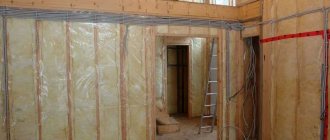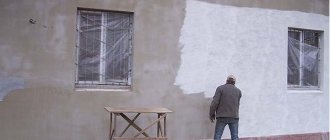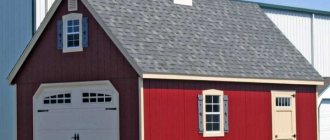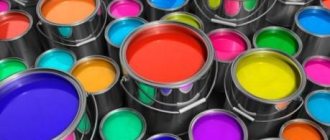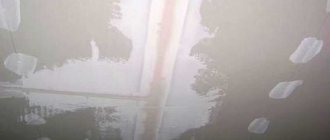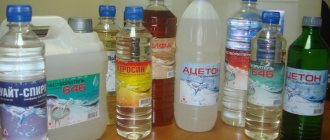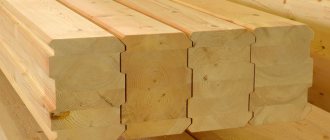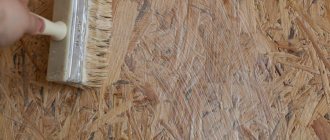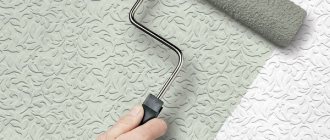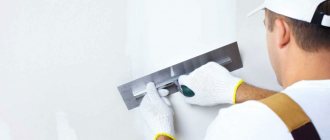Applying a primer before finishing work provides advantages that make the repairs made better, more economical and durable. Depending on the type of materials used, the appropriate soil is selected to ensure maximum efficiency. Neglecting this stage is not saving money, since without surface preparation, the consumption of materials increases, and poor-quality repairs will soon have to be redone.
Is it necessary to prime the surface before plastering, puttying, or wallpapering?
Importance and functions of soil
To understand why you need to prime the walls before applying the finishing material, you should familiarize yourself with the basic properties of the compositions intended for these purposes. So, there are primers:
- Water repellent. Their purpose is to protect the surface from moisture and associated corrosion.
- Deep penetration soils. Used to prepare porous and loose materials for finishing. Penetrating deep into the structure of the base, they strengthen it and reduce the level of moisture absorption.
- Adhesive. The functionality of such compositions is to improve adhesion between the base and the applied material.
- Antiseptic. Protect the base from the influence and proliferation of bacteria, fungi, mold and other flora.
- Fireproof. Reduces the flammability of materials.
The given properties are not necessarily included in the soil alone. Most often, the primer has several positive qualities at once, affecting the surface in a complex manner.
Types of primers
The effectiveness of the primer is influenced by its composition, material and condition of the surface being treated, and the microclimate of the room. The primer can contain mineral oils, resins, adhesives, alkyd and acrylic substances with the addition of coloring pigments, evaporation accelerators, and antiseptics. They can be made on a mineral or polymer basis.
In mineral primers, the main binding component is cement of a certain brand, and acrylic or alkyd additives determine the qualities required for application. Alkyd primers are more commonly used for finishing wood products, while acrylic primers are more versatile. They can be used to treat plasterboard surfaces and plaster. Mineral primers from the Knauf and Ceresit brands are of high quality.
Video: GPS Primer of walls
Polymer-based primers have high adhesive properties and the ability to interact with different materials, as a result of which they are more versatile in use and are more popular. They are also more resistant to external influences - changes in temperature and humidity. Most polymer primers are based on polyurethane or epoxy resin.
Depending on the purpose, primers are divided into the following types:
1. Primers intended for priming concrete surfaces, brickwork, plaster or putty. These include:
- primers for plaster;
- strengthening primers, for loose bases;
- primers with increased adhesion for deep absorption;
- anti-alkaline primers.
2. Primers for wood surfaces are produced in the following types:
- antibacterial impregnations against fungi and insects;
- wood primers;
- wood resin neutralizers;
- special primers for certain types of paints.
3. Metal primers include the following types:
- rust converters;
- primers for non-ferrous metals;
- primers for iron.
4. Special types of primers:
- for waterproofing;
- to remove stains;
- for waterproof materials (laminate, glass, tiles, etc.).
Primer and wallpaper
Do you need a primer for wallpaper? Previously, this material was applied to walls without prior preparation. The results of such repairs were peeling of the material, poor resistance to drafts and high humidity. It’s quite simple to answer the question – why prime the walls before wallpapering? If this is not done, the glue consumption will significantly increase and the adhesion between the wallpaper and the walls will decrease.
It follows from this that the question of whether a primer is needed before wallpapering will have a clear positive answer. Without skipping this important stage, you can achieve uniform setting of the material, as well as durability of the repair made with great effort.
Features of the use of primers
The most universal and popular primers used in wall treatment are deep-penetrating primers. They impregnate the walls before painting, puttying, wallpapering or laying tiles. They perfectly remove dust from the surface and reduce its porosity, preventing excessive absorption of moisture from the applied adhesive solution or paint coating. The most popular and well-known representative of this class of primers is Ceresit ST17.
If the cement screed has dried out and cracked, then treatment with a strengthening primer such as Mapei Prosfas will strengthen it and eliminate cracks. The liquid primer penetrates deeply into the pores and cracks of the cement base and, when dry, tightens and binds the scattered parts of the surface. By impregnating the top layer of the screed with an adhesive to a depth of several centimeters, the primer helps to enhance its strength and load-bearing capacity.
Hydrophobic impregnations are used to treat the surfaces of stone and brick structures and to grout the joints of tile slabs to give them water-repellent qualities. After applying a water-repellent primer, stone or brickwork acquires a completely waterproof surface; it will not absorb moisture and form noticeable dark damp spots.
Video: Maximum penetration of primer into the base
If you are going to finish a wall with a glossy surface, then adhesive primers like Knauf Betonokontakt are best suited for forming an adhesion layer. Such primers contain quartz sand, which gives the wall surface, after the mixture dries, the ideal roughness necessary for strong adhesion to the adhesive solution and finishing material. With their help, you can lay new tiles on old tiles without dismantling.
In cases where the walls to be finished will be used in conditions of high humidity, for example, baths, swimming pools, laundries, etc., before finishing they should be treated with an antifungal primer, which will provide them with resistance to the formation of mold and fungi, significantly extending the period between repairs services. The composition of these primers is universal, providing the treated surface, in addition to bacterial protection, with waterproofing and increased adhesive properties.
Primer for plaster and putty
Let's start with whether a primer is needed before puttying. Most often, leveling walls in this way is carried out on surfaces that are characterized by increased moisture absorption and weak structure. The result is increased material consumption, uneven drying and low strength. That's why you need to prime the walls before applying putty. Preliminary preparation of the base will reduce porosity, strengthen the structure and increase adhesion.
Priming walls before plastering
The same applies to the question of whether a primer is needed after puttying. This material itself has a porous structure, and if the leveled surface is not primed, then subsequent finishing will not be as effective, be it wallpapering or painting.
Basic rules for using primer
To ensure high efficiency of using the primer, you must follow certain rules and requirements for its use:
- You cannot purchase a primer with an expired or expiring shelf life, as the quality of the solution will be reduced.
- Before applying the primer, you should prepare the surface to be treated, which includes cleaning it, eliminating blisters and peelings of old coatings and plaster, deepening and widening the cracks that have formed.
- When applying the primer with a roller, brush or spray gun, you must ensure uniform application without skipping the front and end sections.
- If the solution is quickly and strongly absorbed by the surface being treated, a second layer of primer must be applied after the first layer has dried.
- After applying the primer, you need to give it time to dry completely, the duration of which depends on the composition of the primer and external conditions, room humidity and temperature.
Inexperienced homeowners should remember that using a primer is always better than ignoring it. The principle “you can’t spoil porridge with oil” applies here, and the quality of the finish only improves with it.
Drywall primer
The next pressing question that is worth briefly considering is whether a primer is needed before putting drywall. For these purposes, a special primer is used, the purpose of which is to increase surface adhesion. On primed drywall, the putty holds much stronger. This also applies to cases where wallpaper is glued to gypsum boards or water-based paint is applied.
Priming drywall
Primer. Types, properties, application.
What is primer used for?
Primer or primer is a liquid building material used to prepare the surface and improve the connection of subsequent layers to the base. It consists of a mixture of fillers in a main binder polymer adhesive composition. In this article we will tell you how to choose and use this material correctly.
A primer is a liquid building material used to prepare the surface and improve the connection of subsequent layers to the base. It consists of a mixture of fillers in a binder polymer adhesive composition.
In principle, for these purposes you can take paint or PVA glue diluted in water. But their use of such a primer justifies itself only in the simplest cases - for coating on flat surfaces with normal porosity. In other cases, it is recommended to use special primer mixtures with complex contents.
All coating compositions can be divided into special, impregnating, fixing or penetrators and primers - primers that are used for primary finishing.
The purpose of primer compositions is to increase adhesion between the base and the finishing coating. These are classic, widely used primers without special additives.
Impregnating compositions are used on highly porous and highly liquid-absorbing substrates. They are very economical, as they clog pores and do not allow finishing materials to penetrate far into the material. Sometimes penetrators are used as impregnation.
Universal surface primer
A fixative primer is often used. These compounds are compatible with all types of concrete, plasters and putties and penetrate the base to a depth of 1 to 5 mm. When they dry, they form chains of polymers that make the surface more durable and strong. The absorbency is evened out over the entire area. It is this property that allows you to reduce the consumption of finishing materials and process large areas with little effort.
The resulting coating resembles a microscopic lattice that can “breathe,” that is, allow water vapor to pass through.
Primers are classified according to their binders. There are many groups, some of them are paints diluted with a special composition and used as a base for them. This allows you to significantly reduce the consumption of paint on the first layer, which is not absorbed into the surface.
Mineral-based primers are made from a liquid cement solution, and have another name - “cement laitance”. They are suitable for initial accelerated processing and preliminary leveling of internal walls made of plaster, concrete, brick, gas silicate and expanded clay concrete blocks.
Alkyd compounds are considered most suitable for untreated wood, particleboard and fiberboard. They are said to “puff up” the wood structure, resulting in a smooth surface with excellent adhesion characteristics. It is not recommended to use such primers on plaster or gypsum surfaces because the result is fleecy unevenness.
They form stable compounds with fiberglass, polyvinyl chloride plastic, galvanized steel, glass and tiles.
Among these compositions there are materials with a narrow specialization - moisture-proofing with anti-mold and fungicidal additives and special mixtures that prevent stains from nicotine, smoke, soot and dirty stains from flowing water from appearing on the final coatings. They can be used to prime any surface, including ceilings and floors. Typically a highly pigmented mixture is used to create a semi-matte surface film and enhance the top color. It dries in 12 - 16 hours.
Acrylic emulsion primers are made based on water. They are applicable to almost all surfaces - plaster, cement, concrete, asbestos, wood and wood-based panels and brick walls. Due to their good adhesive properties, they are recommended for use in difficult cases - on previously painted floors and ceilings, under fiberglass wallpaper. They are convenient for consumers - they do not have an unpleasant odor and dry in just 2 - 4 hours.
The disadvantage of this mixture is that it cannot be used to protect metal parts, since it allows moisture and rust particles to pass through. After some time, brown spots will appear on the finish.
Epoxy and polyurethane paints diluted with a special solvent make good primers for preparing the surface for these finishing materials.
Natural shellac primer is made from milky juice diluted in methyl alcohol. It is used to treat knots on tree cuts so that resin does not appear on them. It is used to cover the surface to isolate it from water-soluble paints - stains.
For metal structures, special mixtures are used to protect them from moisture, and they use their own for different metals. To prevent specific damage similar to pockmarks, aluminum is coated with zinc-based primers or urethane paints. Steel and other ferrous metals love alkyd compounds with additives of zinc compounds. The best protection against corrosion is a mixture made with zinc phosphate. The chromate of this metal is excellent for mixed steel and wood structures.
In most cases, copper, brass and bronze products are not painted because they are sold already processed. If the protective coating cracks and peels off, it is recommended to remove it with white spirit. After this, the metal is polished and varnished with epoxy or polyurethane primers.
What is surface priming
The primer must have good penetrating ability and adhere firmly to all types of bases and decorative coatings. This result is achieved by creating a single physico-chemical impregnation system and two adjacent layers. It is impossible to achieve this using any one substance, because all materials are different in structure. Therefore, there is a very wide variety of types of primers.
Typically, well-known manufacturers have lines of varnishes and paints that offer a wide selection of different primers. When it is not clear what is best for a given case, you can almost always choose a product from the same company from which you purchased the remaining materials for the repair.
If the surface is complex, too or not porous enough, contaminated with grease or building materials, then professional primers are needed. They have a proven composition and perform all the necessary functions well, strengthen and protect metal elements from corrosion and secure crumbling particles. When producing them, the type of surface being treated is taken into account - it can be a brick wall, concrete or expanded clay concrete blocks, metal, plaster, plasterboard or wood. Be sure to pay attention to the humidity of the room, as well as the method of further finishing - painting, tiling or plastering.
They contain film-forming substances - resins, bitumen, oils, and various types of glue. They add dyes and substances that speed up drying.
Thanks to this, they can penetrate even small pores of the base and close them. The compositions are capable of binding free, loose particles, gluing them to the surface. They significantly increase the surface's abrasion resistance and strength. But the most important thing is that the absorbency of the surface is leveled. This is explained by the dual properties of the primer. The polymer component firmly adheres to the base, and the film itself behaves like a coating with normal porosity.
This property allows the paint to lay down in an even layer, giving the same color and texture over the entire area.
When decorating with wallpaper, glue consumption is significantly reduced, despite the fact that the wallpaper is stronger and lasts longer on the wall. When working with ceramics, the base must be primed. The fact is that mineral adhesives lose a lot of strength if the water evaporates from them too quickly.
For 1 m2 there is from 100 to 250 g of the mixture, depending on the porosity of the base. This is not the most expensive stage of work - it is 3 - 4 times cheaper than putty. But if you miss it, then you will have to pay with pieces of valuable plaster falling off or peeling flaps of wallpaper. The primer protects the base from damage when removing old coatings.
Conditions of use
Primers must be applied using a roller, brush or other means of application, strictly following the instructions. Priming is not an end in itself, it is only a high-quality preparation of the base for subsequent finishing.
The best adhesion parameters are provided by a normally porous surface.
How to determine the type of surface? To do this, just drop water on it. If the drop disappears in less than 3 minutes, it is a highly porous base. The material on it will peel off along with flakes of concrete or plaster, so experts recommend using fixing compounds.
If water is absorbed for more than 20 minutes, it is a slightly porous coating from which the finish will fall off like dry peels from an onion. Therefore, fixing primers will adhere well to it.
Normal average time is from 3 to 20 minutes. But even within these limits the porosity is naturally different. Therefore, most manufacturers produce formulations of increased concentration. To work, first take several test portions, which are diluted with different amounts of water at room temperature. Then small areas of the surface are treated with a brush, checking which density will be the best. The composition is optimal when a shiny polymer trace remains on the surface. It should not be uniform; there may be areas where the shine will be almost invisible.
The choice of primer type depends on the base and finishing material.
On monolithic concrete walls, from which the first layers of plaster often fall off, it is recommended to apply mineral-based compounds. They can be applied undiluted or mixed with water in a 2:1 ratio.
In damp rooms, it is required that the primer also performs the function of waterproofing. Antibacterial additives are introduced into it to prevent mold from growing on the walls. It is applied in two layers to increase strength and eliminate accidental mechanical damage.
New materials are also appearing: a kind of hybrid of putty and primer, which is diluted with water. It resembles something between these materials in consistency and layer thickness. This material fills small irregularities and is sanded like a regular putty, but its adhesion rates, like those of a primer, are very high. Primer - putty can be used as a finishing layer before painting or applying wallpaper. It adheres well to very difficult surfaces, with the only exception being years of oil paint buildup.
A thicker layer of primer is applied to surfaces that are loose, crumbling, or leaving a chalky mark than to strong, even walls. A layer of 0.2 mm is optimal.
Plaster blocks must be primed before laying tiles. The resulting film will not allow the glue to lose moisture. Otherwise, if it dries too quickly, the strength is lost and the tiles may fly off over time.
The currently popular self-leveling floors are impossible without the use of a primer. Plastic masses are poured onto the floor, and after a while they harden. If you do not prime the surface first, bubbles and uneven spots in the form of holes will appear on it, and it will not be smooth. The masses dry and set evenly.
A primed cement floor practically does not accumulate dust and is less likely to wear out and crack. In addition, it tolerates wet cleaning well, which is very important for housewives who cannot sweep concrete surfaces due to clouds of dust. Sometimes walls under vinyl or fiberglass wallpaper are not primed, rightly believing that it is enough to putty and plaster it. The wallpaper itself in this case plays a certain binding role, but in fact, glue works here instead of primer.
A primer layer may not be applied under the tiles if the base is in good condition.
Based on materials from 41mkad.ru
Primer for painting
And the last question on the topic is whether a primer is needed before painting the walls, and what it does. With this method of finishing a room, a primer layer can significantly reduce the consumption of paint material, as well as reduce the need to apply several layers to obtain a rich, deep color. The paint is applied to the primed wall more evenly, without sudden changes in tone, as happens when painting an unprepared surface.
Priming walls before painting
So, neglecting priming will not be a smart move leading to economy. The time and money spent on priming will make the repair work better and more durable. And painting work will be much easier and faster.
We offer our services for preparing walls for wallpapering . Daily visit of masters. No prepayment. Prices: - removal of old wallpaper 70 rubles/sq.m. m - plaster 500 rub/sq. m - putty 400 rub/sq. m - polishing 150 rub/sq. m - primer 50 rub/sq. m You can view the prices for all our services in the “Price” section.
or click to call: +7(917)-571-01-57
Related articles:
- Gluing sound-absorbing wallpaper Very relevant today is gluing sound-absorbing wallpaper, sometimes they are called noise-absorbing. We offer our services...
- Pasting jute wallpaper Jute wallpaper is a rather exclusive finishing material among other types of fabrics. Using this wallpaper you...
- Pasting duplex wallpaper Not many people know about the existence of duplex wallpaper. However, many people glued just such wallpaper and even...
Why do you need a wall primer and how to use it correctly?
photo from the site https://otdelka-expert.ru
Do not rush to abandon the use of primer, because professionals unanimously repeat that the use of this material is mandatory. Experts explain why a primer is needed before painting: it guarantees the quality of the paint and varnish materials applied to the wall. Moreover, if you apply a primer, you won’t have to worry about working to correct defects on the finished wall in the future. The answer to the question “why do you need a primer before painting?” you can get it in practice very soon. After all, without using a primer, you risk encountering fallen plaster or putty.
Applying a primer as a common finishing material entails a number of errors when used:
- When finishing, you need to remember that the entire surface of the wall should be covered with a primer, otherwise the uncovered parts will certainly become a defect that will remind you of itself in the future.
- A primer is an emulsion containing solvents, glue and various film-forming substances. You should not try to replace it yourself with substances such as water-based paint or polymer dispersion, since they have completely different properties and you will encounter a decrease in the durability of the finishing material.
- On various forums you can come across the question: is it necessary to wash the walls before priming? Here you need to remember that if a greasy stain has formed on the wall, it may appear in the future even under several layers of paint, so it should be washed off before priming. To remove grease stains from walls, you can use a warm 5% soda ash solution. You should also take care to remove rust, mold, mildew and other defects from surfaces.
photo from the site https://potolokspec.ru
- When choosing a primer base, remember that it must match the base of the finishing material in order to properly treat the wall.
Do I need to prime the wall before liquid wallpaper?
Indeed, why do you need to prime the walls for liquid-type wallpaper, when it seems that only a leveled surface is enough for the job? It should be remembered that when liquid gets on an unprimed surface, moisture is absorbed by the base, which disrupts the process of forming the finishing coating.
As a result, the solution sets unevenly and the material peels off from the wall, the color scheme and texture are disrupted. If you prepare the surface with deep penetration impregnation, problems can be avoided.
How to choose a primer.
We all know that now there are a huge number of manufacturers. Some goods are more expensive, some are cheaper. First of all, the price depends on the brand, secondly on the quality of the product. First, let's decide what kind of primer we need. If you need to prime the walls indoors, we are looking for a deep penetration primer for interior work. Such a primer can be in different price categories, even with the same name, but with different characteristics. For example: primer for interior and exterior work, primer for interior work. You will not immediately see such subheadings on a colorful label. When choosing a primer, rely on prices.
All primers have exactly the same composition.
The only difference is the amount of water. The cheaper the primer, the more water in relation to special substances. Therefore, if you need to prime walls for plaster or putty, purchase a more expensive primer. When you prime the walls before painting or before wallpaper, take a cheaper primer. I advise you not to buy a very cheap primer (When there are more than two varieties of the same brand).
When priming the wall in front of the wallpaper, keep in mind that this does not exempt you from priming with wallpaper glue, if this is indicated in the instructions included with the wallpaper. When priming a façade or other building elements located outdoors, use a primer for exterior use. There are also special primers. For example, concrete contact. It consists of a highly concentrated primer and quartz sand. Thanks to this composition, concrete contact, after application, leaves a film with quartz sand particles on the surface. quartz sand creates effective adhesion to subsequent building mixtures (plaster, tile adhesive...).
Personally, I prime the concrete base with an ordinary expensive primer, even before plastering the ceilings. From personal experience, I used concrete contact only once, working with walls painted with oil paint. The oil paint was impossible to remove, and it took too long to do it with a hair dryer. I had to prime the walls with concrete contact, then putty and glue wallpaper. I was pleased with the result - it was fast, and the putty didn’t come off when wallpapering! I recommend using this primer only on problem surfaces. For decorative plaster mixtures and liquid wallpaper, the primer is selected by the manufacturer. There is a special recommended primer for each decorative coating. The seller himself will offer it for your decorative coating. Although primers for decorative coatings consist of quartz sand and soil, I do not recommend replacing them at your own discretion. After all, quartz sand can be larger or smaller and in different proportions. When using a primer for decorative coatings, I recommend trusting the manufacturer and seller. You can check a good primer yourself: wet two fingers with primer and touch them to each other. After a while, your fingers will become slightly sticky. If there is no such result, the primer contains a lot of water. It's better to replace it!
Surface preparation, planning work before priming walls.
Before priming the walls, we will complete all dusty work and prepare the surface. This is done to avoid overuse of primer, double work. Perform all installation and dismantling work. Take care of laying wires, moving sockets and switches.
After cutting the groove, a layer of dust remains nearby. Sweep it away. Sweep the floor. When the floors are covered (linoleum, laminate, parquet...) and you are not going to change it, be sure to cover the floors with cellophane film. The primer dries quickly, leaving stubborn stains.
Primer after putty
Many craftsmen prime the surface before finishing putty, but decide not to use this building mixture after it. The fact is that the solution, due to its abundant sand content, causes the formation of a fairly loose surface, which has an extremely low level of moisture resistance and can lead to peeling of the material in the future. In order to avoid this, it is necessary to treat the surface of the wall with a primer mixture not only before puttying, but also after it.
Thus, the next treatment of the wall allows you to increase adhesion and prevent small particles from falling off. Thanks to the primer, the putty turns into a monolithic slab.
In order for the repair to last for many years, it is necessary to treat it with a primer both before and after puttying.

